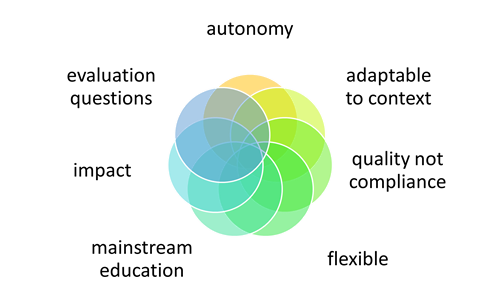How to approach the “TESSIE” framework
While the purpose of TESSIE is to support inspection, evaluation or self-evaluation as a vehicle for improving the outcomes and employment prospects of vulnerable learners, it is also designed to respect the autonomy of schools and inspectorates. TESSIE is not intended to provide a single framework or set of evaluation tools to be used across all schools and inspectorates in Europe. Therefore, it should be adapted to match the needs of the policy environment within which it operates. The aim of TESSIE is to stimulate educations providers and policy makers to further develop policy and practice to actively tackle disadvantage.
The structure of the framework
The framework has 5 sections:
- Context
- Leadership and improving quality
- Climate
- Classroom practice
- Impact
Context
Each school operates in a specific
context (demographics, education policy, financial etc.), which influences what the school does and the choices that it makes. Similarly, understanding learner profile, parental/home environment, the experience of school leaders and of staff as well as governance can play a significant role in helping to get “under the skin” of a school. It is important, when carrying out any (self-) evaluation, that inspectors, school improvement advisers, leaders and practitioners consider the school’s context.
Leadership, climate and classroom practice
The TESSIE framework suggest that practitioners consider these three areas of a school’s work when evaluating how effectively mainstream schools maximise the potential of each vulnerable learner. Each of these areas is split into a series of (self-) evaluation questions. These reflective questions can be viewed as stimulus for schools and inspectorates to develop their own tools for evaluating the quality and impact of a school’s approach to tackling disadvantage. They are not intended to be used as a checklist of features to be complied with. The sequence of questions is not intended to represent any notion of hierarchy. In fact, the user should view the questions as processes that integrate with each other.
Impact
It is essential to evaluate the school’s leadership, climate and classroom provision in the light of its impact on learners and on staff knowledge and practice. This guards against over generous evaluations of actions that have little or no impact, and ensures that schools focus their improvement resources in the right areas.
Key principles for using the framework:

- It is for use in the context of mainstream education.
- It provides a set of suggested evaluation areas and reflective questions to support (self-) evalaution and inspection.
- Users need to adapt the framework to the context of the provider and the education system within which the provider operates.
- There is no hierarchy within the evaluation areas and questions.
- It’s helpful to decide a focus for your evaluation and do not feel that everything has to be looked at at the same time. Look at the questions within each area and decide what are the most relevant aspects you want to explore.
- The questions do not represent a checklist of features that must be complied with. Adapt the reflective questions to suit the setting and the time available to you.
- Take the time to plan how you might explore the questions. What methods will you use? You can use the reflective questions to design your own evaluation tools.
- The quality of the school’s work should always be evaluated and triangulated against its impact on learners and staff.
- It may be helpful to translate the framework to ensure that all parties understand and are committed to its purpose.
Potential methods of evaluation
This list represents a range of approaches and methods that school leaders and teachers, education advisers and inspectors
could use to establish the evidence required to evaluate against the TESSIE framework. It is by no means intended to be comprehensive or exhaustive, and schools and inspectors should not feel compelled to use all of these methods every time and for every aspect of the framework. In fact, inspectors and leaders should be selective and choose the method(s) that will provide the most accurate and relevant information based on the chosen focus of the inspection or self-evaluation
- Observations of teaching and learning
- Observations of the school environment
- Reviews of pupils’ work (standards, progress, skills, teachers’ assessment, follow up, appropriateness of the provision)
- Scrutiny of short, medium and long term planning
- Curriculum organisation
- Interviews with leaders
- Interviews with teachers and discussions of pupils’ work
- Enrichment experiences for disadvantaged
- Tracking system for interventions
- Interviews of support staff carrying out interventions and supporting in class
- Review of the school’s own or external evaluations of pupils’ wellbeing and how these findings are acted upon
- Conversations/meetings with pupils
- Parents’ views – meetings/ questions
- Speaking to partners / discussion with leaders/ teachers how they coordinate work with external agencies
- Individual support plans including their targets
- Tracking systems identifying progress of vulnerable learners
- New emerging methods for engaging digitally – scrutiny of digital files/ videos/ pupils’/ newsletters etc
- Safeguarding culture
- Wellbeing records/ plans/ tracking systems
- Professional learning programmes and teachers’ evaluations of this in light of their practice
- Teachers’ reflections on their own teaching
- School self-evaluation and improvement planning processes
- School policies
- Evaluations of spending (whatever the source) to support inclusion and equity (where appropriate and available to the school)